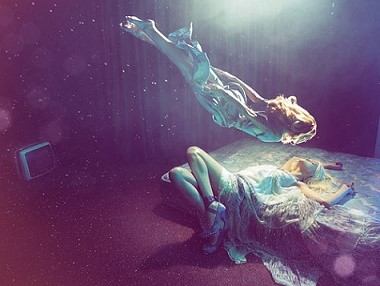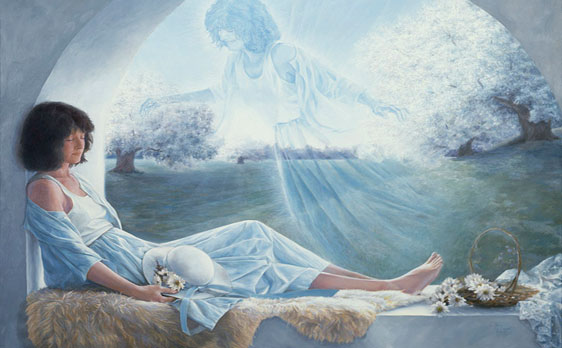Out of body experiences – OOBE
It is often thought that astral projection – out of body experiences or, Autoscopy – is only experienced by people that have had a near death experience after an accident or on the operating table. Out of body experience while sleeping? Not so!
Scientific evidence is now suggesting that we CAN leave our physical body such as in near death experiences and that we may even survive the death of that physical body. Using brainwave technology it was found that a certain combination of alpha and theta harmonics caused the immediate transference of consciousness away from the physical body.
Kinds of OOBEs – Out of body experience meaning
What are some out of body experience causes? What is an out of body dream? The best thing about dreams is that fleeting moment, when you are between asleep and awake, when you don’t know the difference between reality and fantasy, when for just that one moment you feel with your entire soul that the dream is reality, and it really happened.
Almost everyone trying these frequencies has agreed that the effect is very unusual. Several users have reported a distinct ‘moving ‘ of their perception from the physical body. We believe the OOBE experience is an advanced form of astral projection.
It can involve complete secondary body translocation rather than mind projection. A typical example of OOBE or Autoscopy, is where you actually see your physical body in the position you left it. You can even have an out of body experience while awake!

-
Spontaneous OBE
A spontaneous OBE is the experience of leaving one’s physical body, intentionally or otherwise; whether or not it reflects reality remains controversial. It is reported that some of those who recall the experience remember visiting places and people they have never been to or seen before, only to find that they in fact do exist when the individual attempts to retrace their travels in the physical self.
People often report having these experiences after suffering from traumatic experiences such as motor vehicle accidents. People can often remember the accident as if they were observing from a location outside of the vehicle.
-
OBE Initiated during/after sleep
OBEs are often initiated through Lucid dreaming, though other types of initiation also used. In many cases, people claim to have had an OBE, reported being asleep, on the verge of sleep, or having been asleep shortly before the experience.
A large percentage of these cases referred to situations where the sleep was not particularly deep (due to illness, noises in other rooms, emotional stress, exhaustion from overworking, frequent re-awakening, etc.).
In most of these cases, the subjects then felt themselves “wake up”; about half then noted a feeling of physical paralysis. These may be examples of sleep paralysis.
There appear to be two common forms of such lucid experiences. The first involves lucid dreaming, where the subject is immersed in unrealistic worlds, or in a modified form of the reality with impossible or inconsistent features.
A second experience is of a more physical nature where the environment is consistent with reality; this is often called an etheric or ethereal experience. This type can be frightening, as extremely realistic physical sensations may occur, often including magnetic and vibrating phenomena, loss of balance, and confusion.
The person believes he has awoken physically and panic can be caused by the realization that limbs appear to be penetrating objects. Transition can occur between these states one or several times; this transition may feel much like awakening, including the sensation of numbness often felt on awakening.
-
Induced Out of body experiences (non-spontaneous)
Although the above experiences were “spontaneous”, some people have attempted to develop techniques to “induce” an OBE. Methods vary. See below:
- Attempting to fall asleep without losing. This method is generally believed to be what causes involuntary OBEs. Some who use it consider dreams to be a form of OBE in which the conscious mind is suppressed; alternatively, others believe that an OBE is a form of dream in which the conscious mind is not suppressed. A known related technique is for the subject to remind himself of his current position in time and space with daily conscious effort, every now and then. This can then occur during sleep and cause the subject to “awaken” in lucid states required to cause the experience.\
- Deep trance and visualization. The types of visualizations vary; some common imageries used include climbing a rope to “pull out” of one’s body, floating out of one’s body, getting shot out of a cannon, and other similar approaches. This technique is considered hard to use for people who cannot properly relax. Common sensations can arise such as deep vibrations, impressions of very high heart rate (when it actually is in a relaxed state) and these sensations are likely to cause anxieties. A good example of such a technique consists of the popular “Golden Dawn Body of Light Technique”.
- Audio/visual stimulation intended to bring the subject into the appropriate state. An example of this consists of binaural sound technology, in which a constant sound frequency is played in each ear individually, to cause the brain to naturally respond to the rhythm caused by the slight frequency difference between the two. The theta (4Hz)brain wave frequency was observed as effective by the Monroe institute (and corroborated by others). Another popular technology uses sinusoidal wave pulses to achieve similar results. The beta/theta simultaneous brainwave patterns (12Hz/4Hz) were also observed as effective, apparently easing the lighter sleep condition. The theta frequency is observed monitoring brains of dreaming patients, notably in REM (Rapid Eye Movement) sleep, while the beta frequency range is that of normal, relaxed awakened individuals. It is believed that one of the unsuspected powers of the drumming of the American natives during religious ceremonies caused the brain to shift among frequencies to become more receptive to the “other worlds” using similar means.
- Chemically induced experiences. OBEs induced with drugs are generally considered to be hallucinations (i.e., purely subjective), even by those who believe the phenomenon to be objective in general. There are several types of drugs that can initiate an OBE, primarily the dissociative hallucinogens such as ketamine, dextromethorphan (DM or DXM), and phencyclidine (PCP). It has also been reported under the influence of tryptamine psychedelics including dimethyltryptamine (DMT), and ayahuasca. Being under the influence of hallucinogenic drugs are commonly referred to as being in a psychedelic state. The OBE state has been reported as induced by inhalation or ingestion of the entheogen, salvinorin A, derived from the herb, Salvia divinorum (aka Salvia, Diviner’s Sage, Magic Mint, and Maria Pastora). Methamphetamine has also been known to cause OBEs, not in itself but through lack of sleep. It has been reported that it felt like the person was talking above and behind them and, being under the influence of the drug, had no idea what was happening.
- Sensory deprivation or sensory overload. Various techniques aim to cause intense disorientation of the subject by making him lose his space and time references. The first technique, attempting to fall asleep without losing consciousness, can be considered to be a passive form of sensory deprivation. The brain tends to fill in the gaps when there is nothing getting into the senses for some time. Sensory overload consists of the opposite, where the subject can for instance be rocked for a long time in a specially designed cradle, or submit to light forms of torture, to cause the brain to shut itself off from all sensory input. Both conditions tend to cause confusion and this disorientation often permits the subject to experience vivid, ethereal out of body experiences. This tends to happen when the subject believes he or she is in a particular position, whereas his or her actual body is either rocking in a cradle actively, or still lying down. Consciousness suddenly transfers to the mental body.
How to induce out of body experiences?
Imagery Techniques
It is possible to use imagery alone but it requires considerable skill.
a) Lie on your back in a comfortable position and relax. Imagine that you are floating up off the bed. Hold that position, slightly lifted, for some time until you lose all sensation of touching the bed or floor. Once this state is achieved move slowly into an upright position and begin to travel away from your body and around the room. Pay attention to the objects and details of the room. Only when you have gained some proficiency should you try to turn round and look at your own body. Note that each stage may take months of practice and it can be too difficult for any but a practiced OBEer.
b) In any comfortable position close your eyes and imagine that there is a duplicate of yourself standing in front of you. You will find that it is very hard to imagine your own face, so it is easier to imagine this double with its back to you. You should try to observe all the details of its posture, dress (if any) and so on. As this imaginary double becomes more and more solid and realistic you may experience some uncertainty about your physical position. You can encourage this feeling by comtemplating the question ‘Where am I?’, or even other similar questions ‘Who am I?’ and so on. Once the double is clear and stable and you are relaxed, transfer your consciousness into it. You should then be able to ‘project’ in this phantom created by your own imagination. Again, each stage may take long practice.
Inducing a Special Motivation to Leave the Body
You can trick yourself into leaving your body according to Muldoon and Carrington [MC29]. They suggested that if the subconscious desires something strongly enough it will try to provoke the body into moving to get it, but if the physical body is immobilized, for example in sleep, then the astral body may move instead.
Many motivations might be used but Muldoon advised against using the desire for sexual activity which is distracting, or the harmful wish for revenge or hurt to anyone. Instead he advocated using the simple and natural desire for water — thirst. This has the advantages this it is quick to induce, and it must be appeased.
In order to employ this technique, you must refrain from drinking for some hours before going to bed. During the day increase your thirst by every means you can. Have a glass of water by you and stare into it, imagining drinking, but not allowing yourself to do so.
Then before you retire to bed eat ‘about an eighth of a teaspoonful’ of salt. Place the glass of water at some convenient place away from your bed and rehearse in your all the actions necessary to getting it, getting up, crossing the room, reaching out for it, and so on. You must then go to bed, still thinking about your thirst and the means of satisfying it.
The body must become incapacitated and so you should relax, with slow breathing and heart rate and then try to sleep. With any luck the suggestions you have made to yourself will bring about the desired OBE. This is not one of the most pleasant or effective methods.
Another form of a spontaneous OBE occurs during a near death experience (or NDE). The phenomenology of an NDE usually includes physiological, psychological and transcendental factors (Parnia, Waller, Yeates & Fenwick, 2001) such as subjective impressions of being outside the physical body (an out-of-body experience), visions of deceased relatives and religious figures, transcendence of ego and spatiotemporal boundaries and other transcendental experiences (Lukoff, Lu & Turner, 1998; Greyson, 2003).
Typically the experience follows a distinct progression, starting with the sensation of floating above one’s body and seeing the surrounding area, followed by the sensation of passing through a tunnel, meeting deceased relatives, and concluding with encountering a being of light (Morse, Conner & Tyler, 1985).
External verification of OBEs
Few attempts have been made to verify OBE as being “really” out-of-body by checking the positions of people or objects in another room. The basis for the subject’s belief that the experiences were real was not primarily the external evidence. Very few cases considered it needful to verify for themselves they were physically out-of-body by checking on events at other locations. This type of verification was not what caused them to believe the experience was “real” in the first place. Instead, it was the quality of the experience that drove their perception of its reality, and made it different from a dreaming or illusory experience.

